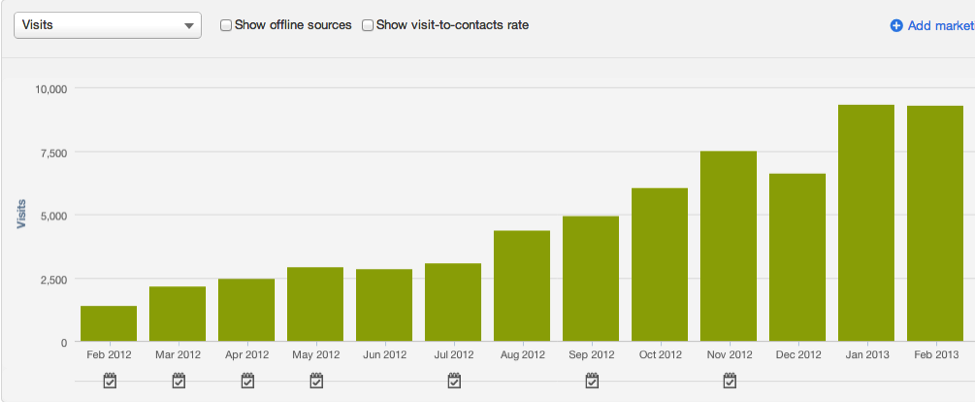Be honest: As a content marketer, you’re maintaining an existence that relies on instant gratification in order to gain fulfillment. Much like the hopeful gym goer denouncing their workout after the scale showed no weight loss after one day, business bloggers are often restless in a similar manner.
“Where’s all the dang traffic?”
It becomes easy to doubt the value of blogging when you’re not seeing results quickly. In fact, very few have the patience and foresight required to persevere those lean days often associated with launching a blog.
However, much like a solid workout plan, persistence – and most importantly, discipline– almost always pays off. Still, wouldn’t we all appreciate an accurate forecast as to when we can expect results from our blogging efforts?
Well, sure. But here’s the thing about forecasts: They suggest that the end result is independent of your own efforts, and are simply to be expected. Results are completely dependent on you, and below I’ll highlight the factors that will determine your timeframe for success.

Identify Your Purpose
What’s your purpose for starting a blog in the first place? If it’s simply due to the persuasive narrative dominating your Twitter feed, you’re already lacking direction and any strategy for achieving results.
What do results even look like, anyways? You first need to define what the overall objective is for blogging as it relates to your overall business goals. Is it to simply generate traffic and raise awareness? Are you trying to drive more qualified prospects to your website in order to improve your opportunity-to-customer rate?
Most importantly, how are you providing value?
This is your content mission statement. Any blogging strategy absent of one will also have a hard time achieving any traction. Asking about results prior to identifying one would be like asking how long it’ll take to lose weight while sitting on the couch with an Oreo sundae. Where’s the accountability?
Finding an Audience
Once you’ve identified a clear content mission statement, you can tailor your blogging initiative to attract the right audience and have a clearer depiction of the results needed to support your business goals.
If you’re looking to jumpstart the success of your blog – and if we’re being honest, who isn’t? – value, volume, and visibility will be your main drivers for getting found as quickly as possible.
- How do I provide value? Easy: start addressing the challenges your ideal customers are facing. Sounds easy, right? Actually, most brands utilize their blog as a vehicle for redirecting their print ads online. Don’t do this. Write down every single question your customers are asking, and answer every one of them in the form of a blog post. Be a resource. Not a self-serving waste of time.
- How do I achieve volume? Write every day. Have a free moment at work? There’s nothing more valuable you could do with that time than to create more content, the more you have, the quicker you’ll see results. There are no shortcuts.
- How do I gain visibility? Develop a strong social media presence and focus on syndicating your content to each platform that makes sense for your company. However, this isn’t paint by numbers. User behavior varies depending on the platform, and the most visible marketers understand this and craft messaging that aligns with these variations. In short, if you’re sharing a blog post over three different social platforms, you should craft three differing messages.
What? Surprised I didn’t wax poetic about the importance of search engines and optimizing for keywords? While I would never minimize the importance of search, I’ve actually never taken the approach of optimizing for search engines. Instead, I optimize for the human. More specifically, this means I use what I learn from our ideal personas to dictate the keywords I use.
I’ve included a graph below highlighting a year in the life relying on this practice:

A 583% increase in organic traffic in one year, simply by understanding the questions the audience was asking and optimizing each post accordingly. It should also be noted that during this time, blog posts were published daily.
As you can see, there’s a direct correlation between volume and visibility. While keyword optimization – both human and search – is important, it’s equally as important to publish something of value as often as possible. Each post offers a new opportunity to gain residual traffic over time. While the graph above shows continual increase over the first five months, notice the tipping point occurred around month six.
The Logistics
We can talk all day about quality and consistency in relation to getting results, but if we don’t understand the mechanics of actually getting found, your efforts would still seem fruitless at the outset.
You’ve heard this before and in order to maintain sanity, I’d suggest pasting it to your monitor: Don’t expect overnight success. If you’ve just started blogging for your business, chances are the domain for your blog is brand new. Search algorithms like Google’s often value older domains with a reputation, so it’s a good rule of thumb to allow around six months to really start gaining traction from search engines.
While Matt Cutts, head of webspam at Google, has done his best in the past to minimize the importance of domain age, even he admits that “as long as the domain has been around for a few months, you should be able to show up in search results."
So if you’re new to blogging, give it time.
One of the common personality flaws of bloggers is impatience. The world needs to see your post, right? After all, you view yourself as a thought leader with years of experience in the industry. Why shouldn’t you expect an influx of visitors immediately after hitting publish?
Well... because it doesn’t work that way. According to Google, crawling and indexing your site pages – of which your blog posts are considered – can “take some time and rely on many factors.”
Each individual blog post is a new page to be indexed by Google. This is both a blessing and a curse for bloggers. A blessing in that it greatly increases your probability for getting found over time, and a curse because you’re frantically refreshing the first page of search results waiting for your article to own the internet.
The Six Month Rule
Often times, personal trainers tell their clients to weigh-in on a weekly basis rather than every day, as doing so is deflating to the overall cause.
The same could be said for blogging. Don’t worry about traffic at the outset. In fact, don’t even bother fretting over waterfall graphs for a while. Focus on creating valuable content consistently, and if you’ve done your homework and have a clear understanding of your audience, trust that they’ll find you.
As traction from the search engines picks around the six month mark, you’ll begin noticing that your older posts are contributing significantly to your overall traffic. It’s around this time you’ll start seeing incremental spikes in traffic, blog subscribers, and most importantly, blogging morale.

